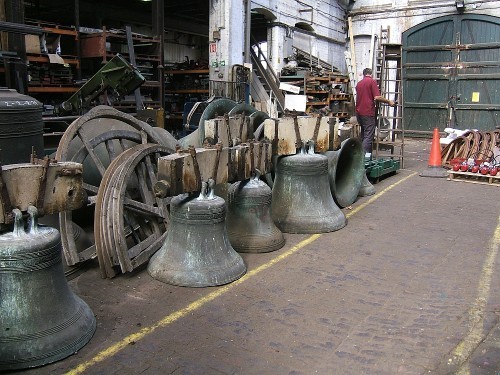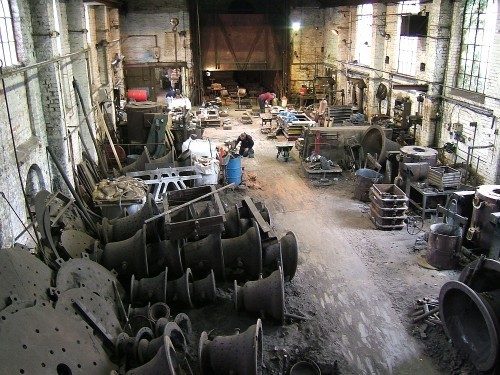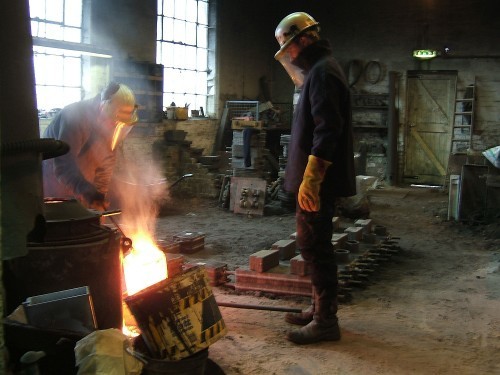An Outing to a Bell Foundry – guest post by Sue
Bell casting first came to my attention when (many years ago) my chemistry teacher in school told the story of a King whose fleet was confined to harbour by a contrary wind. An oracle declared that the wind would change only if a bell was cast and rung. Time and time again the bell was cast but it always emerged cracked. The oracle was again consulted and this time told the king that only the death of his daughter would placate the gods and allow a successful casting. The king refused to sacrifice his daughter but she overheard the prophecy and, because she loved her father, threw herself into the vat of molten metal when the next casting was attempted. The resulting bell was sound and rang true. The wind changed and the fleet sailed. *
With that tale resonating in me, and after following Robin’s blogging about bell ringing, I decided a couple of years ago to visit the John Taylor bell foundry in Loughborough, one of only 2 bell foundries remaining in Britain (the other is Whitechapel’s in London). Mike – my partner and an engineer with absolutely no interest in bells – needed more than a little encouragement to provide chauffeur & companion duties (I too have ME), so I arranged for us to join a tour organised for a Rolls Royce enthusiasts’ group – plenty of like-minded people for him to talk to, I thought.
Bells are made of bronze, an alloy of 77% copper and 23% tin, with slightly more tin being used for handbells.** Other metals can be used but the tone isn’t as good – our guide demonstrated bronze, aluminium, cast iron and steel bells and even a musical novice like me would choose the bronze variety. At the time of our visit, one ton of bell metal cost around £10,000. The bell known as Great Paul, hung in St Paul’s Cathedral in 1881, weighs 17 tons and would cost £1¼m to cast.

Bells and fittings stacked up waiting for recycling. They’ll be either retuned or melted down and recast.
Casting a bell uses two molds, the core and the case. The core is solid and built from various ingredients – loam and manure are two that stick in my memory – and then shaped to the inside of the new bell. The case is a large metal bell-shaped shell and a dozen or so can be seen in the lower half of the photo of the workshop. The core is clamped inside the case and molten bell metal is poured between them.

The workshop area seen from an observation balcony overlooking its length.
Much to my disappointment we didn’t get to see a bell being cast, although bell solder was being poured into small molds amidst much sparking and smoke.

Pouring bell solder into a carrying pot. Its destination was the small molds on the floor behind the man standing. This was the best shot I managed – general light levels were poor but the bell solder was incandescent.
Once the bell has been cast it needs tuning. The bell is mounted upside down on a lathe and turned to remove rings of metal from its inside. We were told that Church bells are tuned using a 5 tone tuning principle, these being:
(1) Hum – lowest note
(2) Fundamental – octave above the hum
(3) Nominal – octave above the fundamental
(4) Tierce – minor 3rd above the fundamental
(5) Quint – 5th above the fundamental

The largest tuning fork I’ve ever seen!
Overall, I had the impression that bell manufacture is a very traditional sort of work; on a cloudy day the work areas looked grimy and it was easy to imagine little might have changed since the Victorian era. Modern technology wasn’t much in evidence although I did see a laptop in the tuning area, alongside an impressive array of tuning forks.
Leaving the foundry, Mike admitted enjoying the tour. He didn’t talk shop with the Rolls Royce people (who were, quite reasonably, interested in what our guide was saying) but there were some lovely, expensive-looking cars parked outside the Foundry – amongst them a 1910ish custom built open topper and a couple of others from the 1930s and ’40s (or so I’m told – I have about as much interest in cars as Mike does in church bells).
All in, a good day and a memorable outing.
* * *
* I am going to rewrite this story. It’s been biting my butt since Sue first sent me a draft of this post. Arrrrgh. If this isn’t a TYPICAL trad-girl story. Oh, dearie me [vigorous hand-wringing] what can I DOOOOOOOO to save the situation? You can diiiiiiiiiiiie. Her father and her people are devastated. She’s still dead. Not in my version. –ed.
** I didn’t know that!!! –ed.
Robin McKinley's Blog
- Robin McKinley's profile
- 7240 followers



